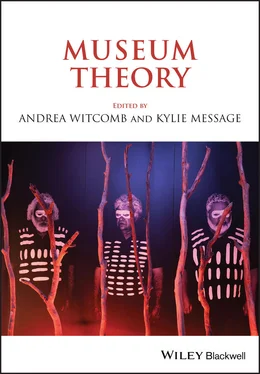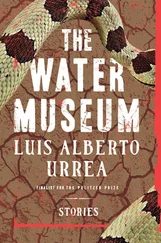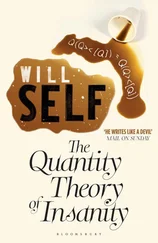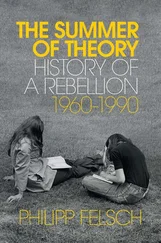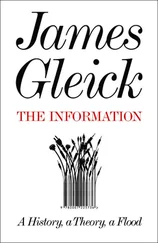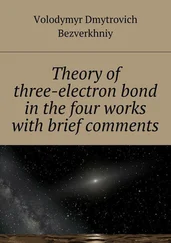In the context of theory on the museum, the chapter has been concerned with the complexity of affecting encounters in generating new ways of imagining interactions between human and nonhuman worlds. The space of new becomings will always benefit from a muting of subjectivity, a possibility affected through encounters with objects that do not operate within human notions of linear history and time. Prepersonal, precognitive affective intelligence is situated outside historical, linear time and is not limited to a common sense past, present, and future. Unfamiliar spaces and times have always been part and parcel of wondrous encounters with museum objects. Notwithstanding the rigor of critical analysis and the large and important body of work in museum studies since the advent of the new museology, the fictional notion of anarchical artifacts that cause havoc in the commonsense, rational museum excites us to the possibilities of our own transformation. After all, who wants a tree in their head?
1 Adorno, T. 1967. “Valéry Proust Museum.” In Prisms, translated by S. Weber and S. Weber, pp. 173–185. Cambridge, MA: MIT Press.
2 Baker, J. 2008. “Beyond the Rational Museum: Toward a Discourse of Inclusion.” International Journal of the Inclusive Museum 1(2): 23–29.
3 Baker, J. Forthcoming. Sentient Relics: Museums and Cinematic Affect. Farnham, UK: Ashgate.
4 Bennett, J. 2005. Empathic Vision: Affect, Trauma, and Contemporary Art. Stanford, CA: Stanford University Press.
5 Bennett, T. 2004. “The Exhibitionary Complex.” In Grasping the World: The Idea of the Museum, edited by D. Preziosi and C. Farago, pp. 413–441. Aldershot, UK: Ashgate.
6 Best, S. 2011. Visualizing Feeling: Affect and the Feminine Avant-Garde. London: I. B. Tauris.
7 Braidotti, R. 2013. The Posthuman. Cambridge: Polity.
8 Brennan, M. 2010. Curating Consciousness: Mysticism and the Modern Museum. Cambridge, MA: MIT Press.
9 Brennan, T. 2004. The Transmission of Affect. Ithaca, NY: Cornell University Press.
10 Clifford, J. 1985. “Objects and Selves: An Afterword.” In Objects and Others: Essays on Museums and Material Culture, edited by G. W. Stocking, pp. 236–246. Madison: University of Wisconsin Press.
11 Clough, P. T., ed. 2007. The Affective Turn: Theorizing the Social. Durham, NC: Duke University Press.
12 Crimp, D. 1985. “On the Museum’s Ruins.” In Postmodern Culture, edited by H. Foster, pp. 43–56. London: Pluto.
13 Damasio, A. 2000. The Feeling of What Happens: Body and Emotion in the Making of Consciousness. London: Heinemann.
14 Deleuze, G., and F. Guattari. 2004. A Thousand Plateaus. Translated by B. Massumi. London: Continuum.
15 Duncan, C., and A. Wallach. (1978) 2002. “The Museum of Modern Art as Late Capitalist Ritual: An Iconographic Analysis.” In Grasping the World: The Idea of the Museum, edited by D. Preziosi and C. Farago, pp. 483–500. Aldershot, UK: Ashgate.
16 Elkins, J. 2004. Pictures and Tears: A History of People Who Have Cried in Front of Paintings. New York: Routledge.
17 Grossberg, L. 1997. Bringing It All Back Home: Essays on Cultural Studies. Durham, NC: Duke University Press.
18 Guattari, F. 1995. Chaosmosis: An Ethico-Aesthetic Paradigm. Translated by P. Bains and J. Pefanis. Sydney: Power.
19 Harris, J. 2001. The New Art History: A Critical Introduction. London: Routledge.
20 Hetherington, K. 1997. “Museum Topology and the Will to Connect.” Journal of Material Culture 2(2): 199–218.
21 Kristeva, J. 1986. Powers of Horror: An Essay in Abjection. New York: Columbia University Press.
22 Massumi, B. 2011. Semblance and Event: Activist Philosophy and the Occurrent Arts. Cambridge, MA: MIT Press.
23 Thrift, N. 2008. Non-representational Theory: Space/Politics/Affect. London: Routledge.
24 Tlili, A. 2008. “Behind the Policy Mantra of the Inclusive Museum: Receptions of Social Exclusion and Inclusion in Museum and Science Centres.” Cultural Sociology 2(1): 123–147.
25 van Alphen, E. 2012. “Making Sense of Affect.” In Francis Bacon: Five Decades, edited by A. Bond, pp. 65–73. Sydney: Art Gallery of New South Wales.
26 Vergo, P., ed. 2000. The New Museology. London: Reaktion.
27 Wallach, A. 2003. “Norman Rockwell at the Guggenheim.” In Art and Its Publics: Museum Studies at the Millennium, edited by A. McClellan, pp. 97–115. Oxford: Blackwell.
Janice Baker is Lecturer in the School of Media, Culture, and Creative Arts at Curtin University, Australia. Her current research explores encounters with material culture and difference through fictional representations of museum artifacts as cinematic images.
Конец ознакомительного фрагмента.
Текст предоставлен ООО «ЛитРес».
Прочитайте эту книгу целиком, на ЛитРес.
Безопасно оплатить книгу можно банковской картой Visa, MasterCard, Maestro, со счета мобильного телефона, с платежного терминала, в салоне МТС или Связной, через PayPal, WebMoney, Яндекс.Деньги, QIWI Кошелек, бонусными картами или другим удобным Вам способом.
